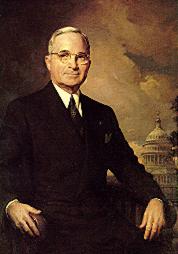|
|
America
in the Late 1940s:
|
"Most
Americans," the Cold War historian Kai Bird has written
("A Foreign Policy for the Common Citizen," The
Nation, May 8, 2000), "have no memory of the designs
Franklin Roosevelt's New Dealers had for postwar American
foreign policy." Bird says the reason is "the duration
and intensity of the Cold War make it difficult to remember
what might have been the common-sensical path not taken at
the end of World War II."
Here
is Bird's list of what President Roosevelt had in mind for
the postwar world: "Human rights, self-determination
and an end to European colonization in the developing world,
nuclear disarmament, international law, the World Court, the
United Nations - these were all ideas of the progressive left.
Even the World Bank and the International Monetary Fund were
initially conceived as vehicles for internationalizing the
New Deal."
That
policy, according to Bird, was embodied in what Roosevelt
had called the "Four Freedoms" - "an attainable
world in which there would be not only freedom of speech and
worship but also freedom from want and fear."
With
Roosevelt's death, in April 1945, policies of fear were re-introduced.
Near the end of his life, Alger Hiss, who, as Secretary General
of the United Nations organizing conference in San Francisco
in 1945, had played an important role in the founding of the
U.N., recalled an early postwar conversation with Dean Acheson,
who became Secretary of State under President Harry S Truman,
Roosevelt's successor. The Cold War with the Russians was
then just emerging, and Acheson, Hiss recalled, considered
it valuable to warn American lawmakers repeatedly about the
many misdeeds of America's rival superpower, the Soviet Union.
"If you don't scare Congress, Alger, they'll go fishing,"
Acheson had said. "But, Dean," Hiss had replied, "if you do
scare them, they'll go crazy."
Two
years later, when Hiss was himself accused before a Congressional
committee (first of Communist sympathies and later of espionage
for the Soviet Union), the Hiss case became one of the defining
- and still highly controversial - episodes of the Cold War.
Victor
Rabinowitz, who served as Alger Hiss's attorney during the
1970s, offered this summary of the postwar years that led
up to the Hiss case (it appears in the 1978 coram nobis brief
Rabinowitz wrote petitioning the federal government to reopen
the Hiss case, based on what was then newly uncovered evidence
that had been released to Hiss by the FBI).
The
trial of Alger Hiss was one of the great state trials in the
recent history of the United States. It had its genesis in
the hearings of the House Committee on Un-American Activities
in the summer and fall of 1948, but those hearings themselves
were part of the larger picture of the Cold War. The House
Committee hearings took place against the closely contested
1948 presidential election between President Truman and Governor
Thomas E. Dewey, which itself was set against the increase
in political tensions both nationally and internationally.
 In
March 1946, Sir Winston Churchill had delivered his "Iron
Curtain" speech at Fulton, Missouri. The Soviet blockade of
Germany followed shortly thereafter and the Berlin airlift
began in response. In February 1948 the Soviet Union had occupied
Czechoslovakia, and events in Greece had raised fears that
armed conflict between the Western powers and the Soviet Union
might break out in that area of the world. In
March 1946, Sir Winston Churchill had delivered his "Iron
Curtain" speech at Fulton, Missouri. The Soviet blockade of
Germany followed shortly thereafter and the Berlin airlift
began in response. In February 1948 the Soviet Union had occupied
Czechoslovakia, and events in Greece had raised fears that
armed conflict between the Western powers and the Soviet Union
might break out in that area of the world.
Tensions
also increased internally. President Truman had instituted
a Loyalty Program for all federal employees as early as March
1947; Congressmen Karl Mundt and Richard Nixon had combined
to sponsor a bill outlawing the Communist Party; and labor
unions were wracked with charges of "Red" leadership, resulting
in the wholesale expulsion of many militant leaders.
 The
House Committee on Un-American Activities played its own role
in the political conflicts that were developing. In the summer
of 1948, Elizabeth Bentley had submitted to the Committee
her tale of Communist conspirators in the country; J. Parnell
Thomas, then chairman of the Committee, said, years later,
that the chairman of the Republican National Committee "was
urging me in the Dewey campaign to set up the spy hearings
. . . in order to put the heat on Truman" (N.Y. Times,
Feb. 8, 1954). The
House Committee on Un-American Activities played its own role
in the political conflicts that were developing. In the summer
of 1948, Elizabeth Bentley had submitted to the Committee
her tale of Communist conspirators in the country; J. Parnell
Thomas, then chairman of the Committee, said, years later,
that the chairman of the Republican National Committee "was
urging me in the Dewey campaign to set up the spy hearings
. . . in order to put the heat on Truman" (N.Y. Times,
Feb. 8, 1954).
It
was in this setting that, on August 3, 1948, Whittaker Chambers
testified at a HUAC hearing that Hiss had been a member of
an "underground" group of the Communist Party during his government
employment from 1934 to 1937. At the time Chambers made his
charges, Hiss was president of the Carnegie Endowment for
International Peace, after having rendered distinguished service
in the government. His employment in the State Department,
and his close association with the Yalta Conference and the
United Nations, made him a prominent target for the anti-Truman
forces. His conviction quickly became a political issue and,
for some, a political necessity.
|

